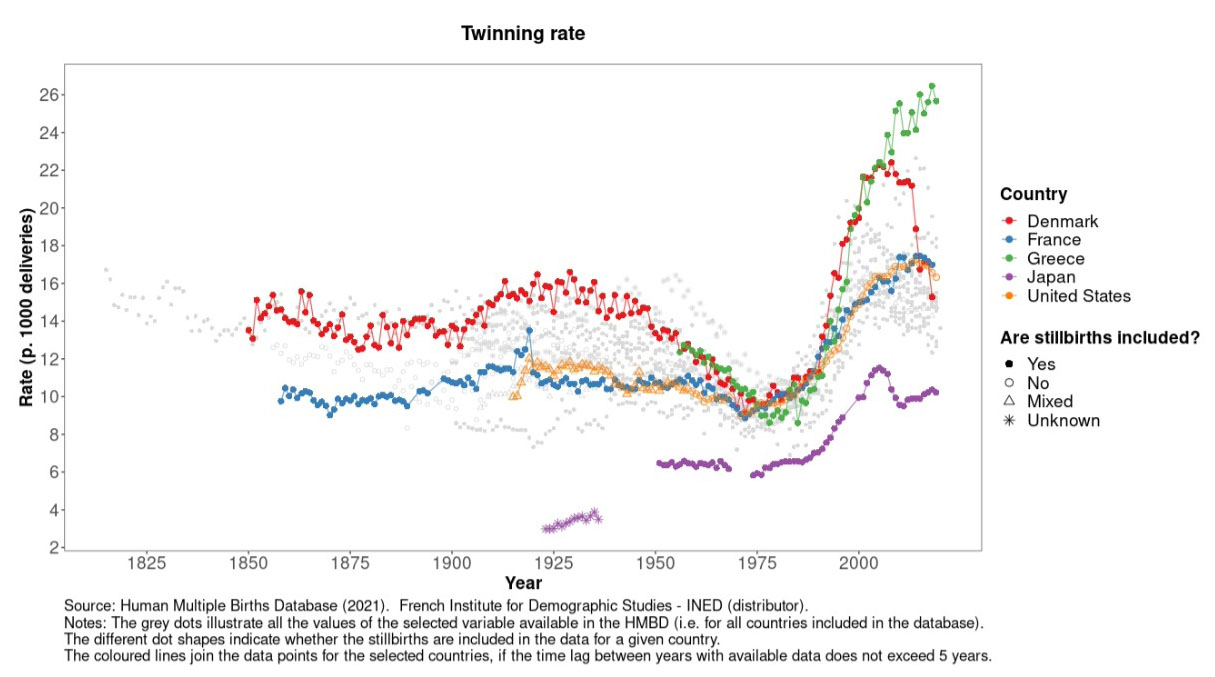Twins have had a prominent role in cultural stories all over the world. So many traditions have them: Romulus and Remus (Latin); Freyr and Freyja (Norse); Apollo and Artemis (Greek); Ashwini Kumaras (Hindu); Ibeji (Yoruba); Xbalanque and Hunahpu (Mayan); and so on. There is something fascinating about identical twins and something magical about the connection twins often have. Twins are so uncommon that their presence in stories (as in the real world) stands out and invites interest. And so, they make for great protagonists.
These days, though, they are less rare than they used to be. A paper from earlier this year documents the starting rise of twinning. The number of twins has increased dramatically and noticeably in nearly all developed countries since 1970.
How much do we know about the increase in twin deliveries, and what might explain it?
What the data shows
There is a freely available resource known as the Human Multiple Births Database (HMBD), which documents, as reliably as possible, twin birth rates across most developed countries. The data comes only from countries with verifiable civil registries, but this data can be surprisingly old. Sweden, for instance, has uninterrupted birth registrations from 1815, and Denmark from 1850.
While there was an 8% increase in all births, there was a 42% increase in twins.
The accounts of twin births are then cross-referenced against the number of births reported that year (accounting for stillbirths). The researchers tried to resolve any anomalies by contacting various countries’ healthcare institutions, but any major, unresolved discrepancies were cleaned from the dataset. This is all to say: the HMBD is a reputable source, and their findings are the closest we can come to knowing what’s happening with twins (and triplets).
And what is happening? Well, they noticed that “from the mid-1970s, an unprecedented and rapid increase [in twin rates] occurred, with figures doubling over the next 40 years in many countries.” This reached a peak between 2010 and 2015 in all countries except in South America. To put this another way, while there has been an 8% increase in all deliveries worldwide, there has been a 42% increase in twins.

Having kids later in life
So why has there been such a dramatic and noticeable increase in the number of twins? Torres et al. cite two major factors (there may be others, but they are comparatively small or inconclusively proven).
First, an increase in childbearing age. In almost all countries in the world, and especially noticeably in developed countries, women are having children later in their lives. In the US, for instance, the mean age of a first-time mother in 2005 was around 25 years old; today, it’s 27 years old. Italy and Sweden have the highest average age of first-time mothers at 31.6. As the paper notes, “the likelihood of twin pregnancy increases with the mother’s age (over the age range 15–37 years).” Women are having kids later, and that means a greater chance of twins.
Medically assisted reproduction
Perhaps the largest change in the last 50 years has been the invention and popularity of medically assisted reproduction (MAR). MAR has utterly transformed childbirth and fertility. This usually involves some kind of artificial reproductive technology like IVF or intracytoplasmic sperm injection (where a single sperm is injected into an egg). It could also be simpler techniques, like ovarian simulation.
Depending on the country, the increased use of MAR accounts for up to 87% of the increase in twin rates. Roughly a third of US adults have done so or know someone who has used fertility treatment. It’s closer to half for those with incomes higher than $75,000. More and more women are using MAR, and, with some statistics suggesting that 40% of IVF pregnancies will result in twins (compared with 2% in the general population), the HMBD’s findings make sense.
A world of twins?
So, at this rate, does it mean that the world will be populated by greater and greater numbers of twins? Will single births one day be the anomaly? Well, not likely.
As noted earlier, the increase in twin birth rates peaked around 2015, and there’s a reason for that. Over the last few years, MAR techniques like IVF have improved considerably, and the rates of multiple births have dropped considerably. Data from the UK shows that the chance of having twins with IVF, for mothers under 35, was roughly 27% in 2007. Today, it’s more like 6%.
Similar trends appear all over the developed world. As the paper notes, “The increase in twinning rates due to MAR has raised concerns among governments and medical authorities, leading to changes in MAR regulations and practices in most developed countries.” For instance, the mean number of embryos transferred has been reduced. This explains why the increase seems to have plateaued and is decreasing in many countries (notably Denmark).
Twins have, historically, been a rare, magical event. It looks like they’ll continue to be so.
We’d love to hear from you! If you have a comment about this article or if you have a tip for a future Freethink story, please email us at [email protected].






